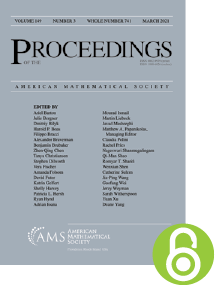Topological spaces that are $\alpha$-favorable for a player with perfect information
HTML articles powered by AMS MathViewer
- by H. E. White PDF
- Proc. Amer. Math. Soc. 50 (1975), 477-482 Request permission
Abstract:
The class of spaces mentioned in the title is closely related to the class of $\alpha$-favorable spaces introduced by G. Choquet [3]. For convenience, call the spaces mentioned in the title weakly $\alpha$-favorable. The following statements are true: (1) every dense ${G_\delta }$ subset of a quasi-regular, weakly $\alpha$-favorable space is weakly $\alpha$-favorable; (2) the product of any family of weakly $\alpha$-favorable spaces is weakly $\alpha$-favorable; (3) any continuous, open image of a weakly $\alpha$-favorable space is weakly $\alpha$-favorable; (4) a quasi-regular space with a $\sigma$-disjoint pseudo-base is weakly $\alpha$-favorable if and only if it is pseudo-complete in the sense of J. C. Oxtoby; and (5) the product of a weakly $\alpha$-favorable space and a Baire space is a Baire space.References
- J. M. Aarts and D. J. Lutzer, Completeness properties designed for recognizing Baire spaces, Dissertationes Math. (Rozprawy Mat.) 116 (1974), 48. MR 380745
- J. M. Aarts and D. J. Lutzer, Pseudo-completeness and the product of Baire spaces, Pacific J. Math. 48 (1973), 1–10. MR 326666 G. Choquet, Lectures on analysis. I: Integration and topological vector spaces, Benjamin, New York, 1969. MR 40 #3252.
- John C. Oxtoby, Cartesian products of Baire spaces, Fund. Math. 49 (1960/61), 157–166. MR 140638, DOI 10.4064/fm-49-2-157-166
- H. H. Wicke and J. M. Worrell Jr., Open continuous mappings of spaces having bases of countable order, Duke Math. J. 34 (1967), 255–271. MR 210084
Additional Information
- © Copyright 1975 American Mathematical Society
- Journal: Proc. Amer. Math. Soc. 50 (1975), 477-482
- MSC: Primary 54E99; Secondary 54C50
- DOI: https://doi.org/10.1090/S0002-9939-1975-0367941-0
- MathSciNet review: 0367941


